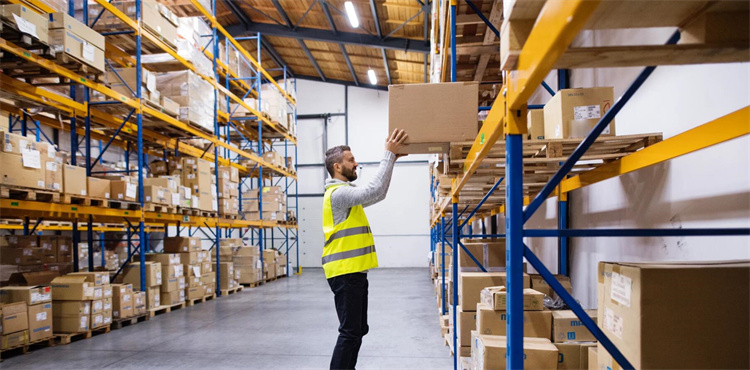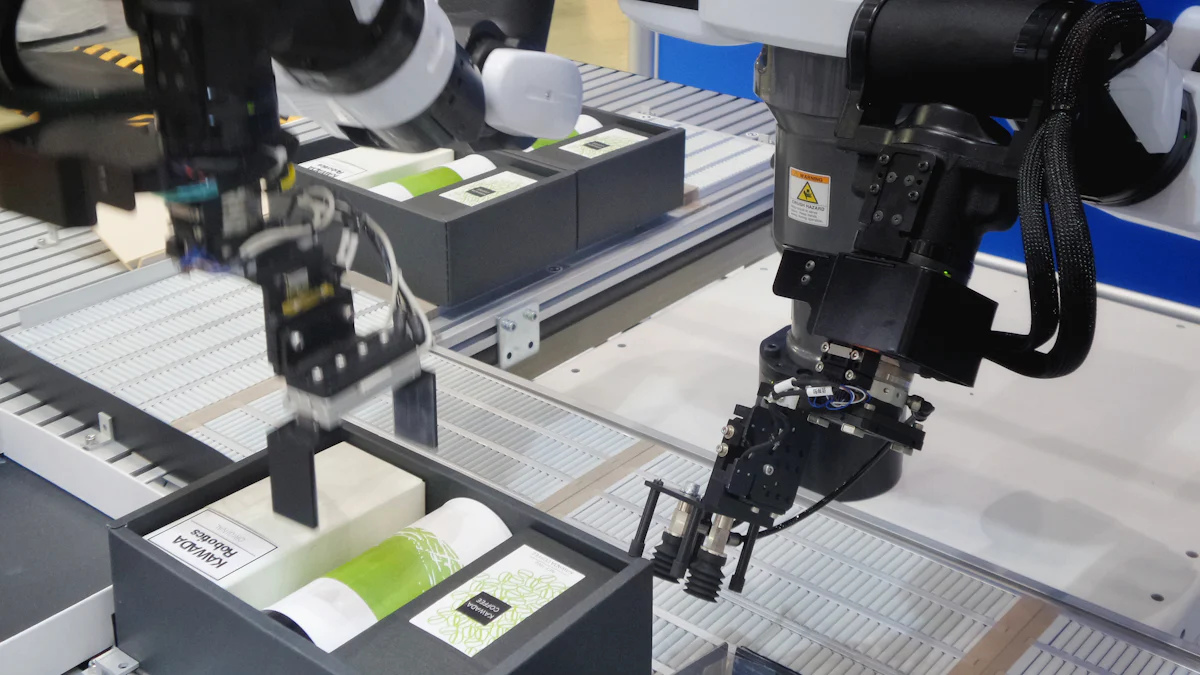The Future of Logistics: Harnessing AI and Robotics for Efficiency

Efficiency is paramount in the realm of logistics, where every second counts in meeting customer demands. The integration of robotics technology and AI has sparked a revolution, reshaping traditional supply chain operations. These innovations optimize inventory management, streamline order fulfillment, and enhance last-mile delivery. With AI algorithms boosting warehouse efficiency by 50% and reducing labor costs by 70%, the industry is witnessing a significant transformation. Embracing these advancements ensures not just cost-effectiveness but also an unparalleled customer experience.
Robotics Technology in Logistics

In the realm of logistics, robotics technology is spearheading a wave of innovation, revolutionizing traditional supply chain operations. The integration of autonomous robots and drones presents promising opportunities for enhancing efficiency and productivity across various tasks. These technological advancements are reshaping the landscape of logistics by optimizing processes and ensuring timely deliveries.
Autonomous Robots
Autonomous robots play a pivotal role in transforming warehousing operations. By leveraging cutting-edge technology, these robots streamline inventory management and order fulfillment processes with unparalleled precision. The deployment of autonomous robots in warehouses enhances operational efficiency, reduces errors, and maximizes revenue potential.
Role in Warehousing
The introduction of autonomous robots in warehousing environments has led to a significant improvement in overall efficiency. These robots are adept at navigating complex warehouse layouts, swiftly locating and retrieving items for order fulfillment. By automating repetitive tasks, they enable warehouse staff to focus on more strategic responsibilities, thereby increasing productivity levels.
Impact on Distribution Centers
The impact of autonomous robots extends beyond warehousing to distribution centers, where they optimize logistical operations. These robots facilitate seamless movement of goods within distribution centers, ensuring swift processing and dispatch of orders. By streamlining distribution workflows, autonomous robots contribute to cost reduction and enhanced customer satisfaction.
Drones
Drones represent a cutting-edge solution for various delivery applications within the logistics industry. Their ability to navigate challenging terrains and deliver packages to remote locations makes them invaluable assets for expedited deliveries. While drones offer numerous benefits, they also pose certain challenges that need to be addressed for widespread adoption.
Delivery Applications
The utilization of drones in delivery applications enables rapid transportation of goods over short distances. Drones can bypass traffic congestion and deliver packages directly to customers' doorsteps with remarkable speed and efficiency. This innovative approach to last-mile delivery enhances the overall customer experience by ensuring timely arrivals.
Benefits and Challenges
The benefits of drone technology in logistics are manifold, ranging from accelerated delivery times to reduced operational costs. Drones enhance operational agility by enabling quick response times for urgent deliveries and improving supply chain visibility. However, challenges such as regulatory restrictions and limited payload capacities present obstacles that require innovative solutions for seamless integration.
Robotics Technology in Hazardous Tasks
Robotics technology plays a crucial role in mitigating risks associated with hazardous tasks within the logistics sector. By assigning robots to handle dangerous materials or environments, organizations can ensure employee safety while maintaining operational efficiency.
Safety Improvements
The deployment of robotics technology in hazardous tasks significantly enhances workplace safety standards. Robots can navigate hazardous environments without risking human lives, minimizing the likelihood of accidents or injuries. By automating high-risk activities, organizations prioritize employee well-being while achieving optimal task outcomes.
Efficiency Gains
Integrating robotics technology into hazardous tasks results in substantial efficiency gains across logistical operations. Robots excel at executing repetitive or strenuous tasks with precision and consistency, leading to improved productivity levels. The automation of hazardous activities not only boosts operational efficiency but also optimizes resource utilization within the supply chain ecosystem.
AI in Logistics

In the realm of logistics, AI plays a pivotal role in optimizing operations and enhancing efficiency throughout the supply chain. From route optimization to predictive analytics, AI technologies are reshaping traditional logistics practices, driving cost savings and improving customer satisfaction.
Route Optimization
AI technology enables logistics companies to make real-time adjustments to delivery routes based on dynamic factors such as traffic conditions, weather patterns, and order volumes. By analyzing vast amounts of data instantaneously, AI algorithms can identify the most efficient routes for deliveries, ensuring timely arrivals and minimizing delays.
Cost Reduction
One of the key benefits of AI in logistics is its ability to reduce operational costs through optimized route planning. By streamlining delivery routes and minimizing unnecessary detours, companies can save on fuel expenses and vehicle maintenance costs. Additionally, AI-driven route optimization leads to improved resource utilization and enhanced overall efficiency.
Predictive Analytics
Demand Forecasting
AI solutions leverage predictive analytics to forecast demand patterns accurately. By analyzing historical data and market trends, AI algorithms can predict future demand fluctuations with high precision. This enables logistics companies to optimize inventory levels, prevent stockouts, and meet customer demands effectively.
Inventory Management
AI technologies revolutionize inventory management by automating processes such as stock replenishment and order fulfillment. Through advanced algorithms, AI systems monitor inventory levels in real-time, triggering automatic reorder points when supplies run low. This proactive approach minimizes stock holding costs while ensuring seamless operations.
AI in Last-Mile Delivery
Enhancing Customer Experience
AI-powered last-mile delivery solutions focus on enhancing the overall customer experience by providing real-time tracking updates and personalized delivery options. By optimizing delivery schedules and routes, AI ensures that packages reach customers promptly and securely. This level of transparency fosters trust and loyalty among consumers.
Reducing Delivery Times
The integration of AI in last-mile delivery operations significantly reduces delivery times by optimizing driver routes and prioritizing urgent shipments. Through machine learning algorithms, AI systems adapt to changing traffic conditions and unforeseen obstacles in real-time, ensuring swift deliveries without compromising service quality.
Future Trends
Integration of AI and Robotics
Seamless Operations
The seamless integration of AI and robotics in logistics heralds a new era of operational efficiency. By combining the cognitive capabilities of AI with the physical prowess of robotics, companies can achieve unparalleled precision and optimization in their supply chain processes. This synergy ensures that tasks are executed seamlessly, from inventory management to order fulfillment, leading to enhanced productivity levels.
Increased Agility
The convergence of AI and robotics empowers logistics operations with increased agility and adaptability. Through real-time data analysis and autonomous decision-making, systems can swiftly respond to changing market demands and unforeseen disruptions. This agility enables companies to optimize resource allocation, mitigate risks effectively, and maintain a competitive edge in the dynamic logistics landscape.
Sustainability
Reducing Carbon Footprint
Sustainability lies at the core of future logistics trends, with a focus on reducing the carbon footprint through innovative technologies. The integration of AI and robotics enables companies to optimize transportation routes, minimize fuel consumption, and lower emissions. By embracing eco-friendly practices and leveraging intelligent solutions, organizations can contribute to a greener supply chain ecosystem.
Efficient Resource Utilization
Efficiency in resource utilization is paramount for sustainable logistics practices. The combination of AI algorithms and robotic technologies allows for precise resource management across the supply chain. From optimizing warehouse space to maximizing vehicle capacity utilization, these innovations ensure that resources are allocated efficiently, minimizing waste and enhancing overall operational sustainability.
Education and Training
Preparing Workforce
As the logistics industry evolves with advanced technologies, investing in education and training programs becomes imperative. Companies must prepare their workforce for the digital transformation by providing specialized training on AI, robotics, and automation tools. Equipping employees with the necessary skills ensures smooth adoption of new technologies and fosters a culture of innovation within the organization.
Adapting to Technological Changes
Adaptability is key in navigating the ever-changing technological landscape of logistics. Continuous learning and upskilling are essential for employees to stay abreast of emerging trends in AI and robotics. By encouraging a proactive approach to technological changes, companies can cultivate a workforce that embraces innovation, drives operational excellence, and propels the industry towards a more efficient future.
In the realm of logistics, the fusion of AI and robotics has ushered in a new era of efficiency and innovation. From autonomous robots optimizing warehousing tasks to drones revolutionizing delivery applications, the landscape of supply chain management is evolving rapidly. The ongoing advancements in AI algorithms and predictive analytics are reshaping demand forecasting and inventory management practices. Looking ahead, embracing these technologies will be crucial for companies aiming to enhance sustainability, agility, and operational excellence in the dynamic logistics environment. As the industry continues to embrace automation and intelligence, the future of logistics holds boundless opportunities for growth and optimization.
See Also
Exploring the Hidden AI Potential in Logistics
Revealing Tomorrow's Supply Chain with AI Integration
Maximizing Warehouse Efficiency with Logistics Robotics
